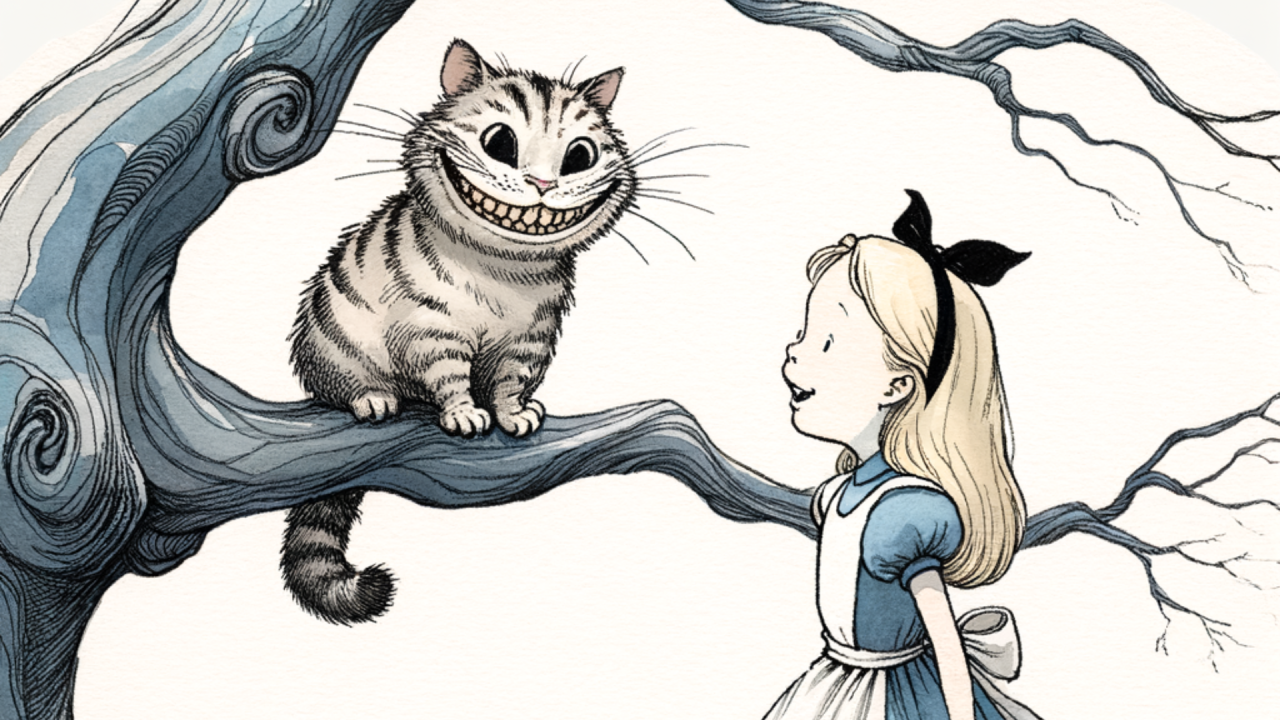
The Wry Grin of Wonderland: Unpacking the Cheshire Cat
“But I don’t want to go among mad people,” Alice remarked.
“Oh, you can’t help that,” said the Cat: “we’re all mad here. I’m mad. You’re mad.”
“How do you know I’m mad?” said Alice.
“You must be,” said the Cat, “or you wouldn’t have come here.”
Alice didn’t think that proved it at all; however, she went on “And how do you know that you’re mad?” “To begin with,” said the Cat, “a dog’s not mad. You grant that?”
“I suppose so,” said Alice.
“Well, then,” the Cat went on, “you see, a dog growls when it’s angry, and wags its tail when it’s pleased. Now I growl when I’m pleased, and wag my tail when I’m angry. Therefore I’m mad.”
(Lewis Carroll, Alice’s Adventures in Wonderland)
We're all mad here
Lewis Carroll's enduring classic Alice's Adventures in Wonderland overflows with unforgettable characters, from the perplexed Alice to the frantic White Rabbit, the contemptuous Caterpillar, the indomitable Queen of Hearts and the enigmatic Cheshire Cat.
When he leaves his trademark grin lingering behind him after he disappears, the Cat embodies, or disembodies, the story's exploration of reason, perception, and conformity. His declaration that "We're all mad here" resonates through the absurd and chaotic wordscape of Wonderland, inviting us to look beyond the individual mind to the shared madness of conformity and nonconformity.
Alice encounters the Cheshire Cat perched in a tree, dissolving away until only his grin remains visible. She has already been scolded for not knowing that this is precisely what Cheshire Cats do. His shape-shifting nature establishes him as a perplexing guide who challenges Alice's notions of reality and logic.
When he says "we're all mad here," the Cat draws attention to Wonderland's chaotic dream logic where sanity is revealed to be a matter of perspective, as well as a matter of advantage or disadvantage. The Cheshire Cat’s insight pierces through the madness to reveal the arbitrary rules and contradictions governing both Wonderland and the waking world.

Alice expresses apprehension about entering a "mad" world, but the Cheshire Cat suggests madness in Wonderland is inescapable, uttering definitively, "We're all mad here." His matter-of-fact assertion that everyone, including himself and Alice, is equally mad upends Alice's conceptions of sanity. The Cat frames madness not as raving lunacy but as a shared condition linking all the inhabitants of Wonderland.
When Alice questions how he determined she is mad, the Cat presents a circular argument based on her presence in Wonderland as apparent proof of her madness. His logic parodying conventional reasoning reveals the subjectivity involved in defining sanity. The Cat exposes the flawed, arbitrary ways society applies labels like "mad."
Challenging Alice further, the Cat offers his unconventional reversal of a dog's behaviors as evidence of his own madness. This absurd comparison satirizes standardized social norms used to assess the soundness of a mind. The Cat's wry self-diagnosis as "mad" demonstrates how conformity to societal standards does not necessarily indicate sanity.
Through these exchanges, the Cheshire Cat utilizes paradoxes and logical fallacies to destabilize fixed notions of sanity. His proclamation of collective madness in Wonderland suggests that commonly accepted social rules and judgments may themselves be absurd.

The Cat embodies, or disembodies, the Trickster archetype, an agent of chaos who reveals deeper truths through humor and absurdity. His words and actions disrupt norms and reverse expectations, forcing readers to move beyond preconceived notions. The Cat pushes Alice to reckon with Wonderland's absurd social order rather than blindly accept it.
This defiance aligns with the common interpretation of his "madness" as a call to embrace nonconformity and individuality. In Wonderland, the Queen of Hearts wields the threat of execution for those deemed mad. Her autocratic rules constrain subjects, demanding rigid obedience to maintain power. When the Cat flouts these rules with cavalier disregard, he celebrates creative thinking and the courage to challenge conformity.
The Cat's smiling philosophizing confronts Alice —and readers—with the need to reevaluate rigid assumptions about rationality and normalcy. In just a few lines, the Cheshire Cat deftly unravels seeming certainties, urging upon us greater openness and critical thinking rather than blind acceptance of arbitrary social conventions.